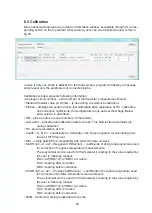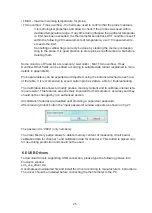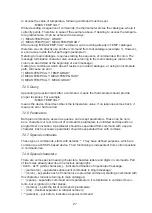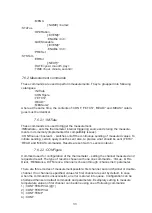
38
7.6.7 :MEMory – internal EEPROM memory handling
This directory is used to operate the EEPROM memories located on the analogue board
and the EEPROMs inside the thermometer probes. In firmware version 1.24 the only active
memory function is clearing memory :CLEar. It allows to delete data in the memory asso-
ciated with the module. The thermometer has three defined memory areas:
• METer – memory located on the analogue (measuring) board: resistance calibration data,
board’s serial number.
• CH1 (CHannel 1) – the memory associated with the probe in the channel 1 : memory in
-
side the probe , as well as an area dedicated to the memory of the probe on the analogue
board. Contains probe’s serial number, calibration data etc.
• CH2 (CHannel 2) – the memory associated with the probe in the channel 2 : memory in
-
side the probe , as well as an area dedicated to the memory of the probe on the analogue
board. Contains probe’s serial number, calibration data etc.
The way of operating memory in CH1 and CH2 is due the fact, that the thermometer that
can operate with probes equipped with an internal EEPROM, and with “bare” probes
without EEPROM memory. In the second case, data are stored in analogue circuit memory.
The command :CLEar includes an additional default sub-command : NAME for compliance
with the standard.
Therefore, erasing memory in a first channel of the probe can be done in two ways:
1) :MEM:CLEar:NAME CH1
2) :CLEar:NAME CH1
To prevent accidental deletion of data , before attempting to erase the memory the user
must first unlock access to calibration using the command: CAL : SEC . Deleting data from
the EEPROM does not delete them from RAM memory of the thermometer. Therefore,
after deleting memory the meter must be restarted.
7.6.8 :DISPlay – display operations
Following catalogue is used to operate the display of thermometer. It contains only one
command - :MENU, which switches the values displayed by thermometer.
The temperature is the basic function of the meter and is always displayed. Additionally, as
the second parameter, the user can display results:
• GRADient – the temperature gradient per second
• DIFFerence – the difference between the temperatures of probes in the first and second
channel,
• RESistance – the resistance of the probe’s sensor,
• NONE – additional results are not displayed (for clearance).
To set the display mode the user must call this command with the name of the menu as
a parameter. Command :MENU includes an additional default sub-command: NAME for
compliance with the standard. Therefore, for example, the display setting of the gradient
can be done in two ways:
1) :DISP:MENU:NAME GRAD
2) :DISP:MENU GRAD
Sending this command without passing any parameter, but as a query, will cause the de-
vice to return current name (GRAD, RES etc.). After switching off, the thermometer stores
scale that had been used recently.
Summary of Contents for LDT 2000
Page 1: ...1 LDT 2000 PRECISION THERMOMETER MANUAL...
Page 14: ...14 5 Typical performance of the thermometer...
Page 15: ...15...
Page 16: ...16...
Page 17: ...17...
Page 43: ......
Page 44: ......







































